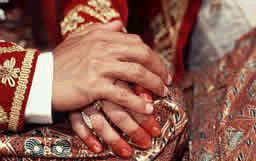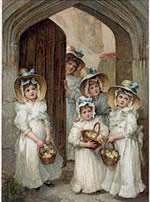 Finland: Brides wear golden crowns. After the wedding, unmarried women dance in a circle around the blindfolded bride, waiting for her to place her crown on someone's head. It is thought that whoever she crowns will be the next to wed. The bride and groom have seats of honor at the reception. The bride holds a sieve covered with a silk shawl; when the guests slip money into the sieve, their names and the amounts given are announced to those assembled by a groomsman.
Finland: Brides wear golden crowns. After the wedding, unmarried women dance in a circle around the blindfolded bride, waiting for her to place her crown on someone's head. It is thought that whoever she crowns will be the next to wed. The bride and groom have seats of honor at the reception. The bride holds a sieve covered with a silk shawl; when the guests slip money into the sieve, their names and the amounts given are announced to those assembled by a groomsman. Greece: The koumbaros, traditionally the groom's godfather, is an honored guest who participates in the wedding ceremony. Today, the koumbaros is very often the best man, who assists in the crowning of the couple (with white or gold crown, or with crowns made of everlasting flowers, or of twigs of love and vine wrapped in silver and gold paper), and in the circling of the altar three times. Other attendants may read Scripture, hold candles, pack the crowns in a special box after the ceremony. To be sure of a "sweet life", a Greek bride may carry a lump of sugar in her glove on wedding day.
芬兰:新娘头戴金色的花冠。婚礼后,未婚妇女围着被蒙住眼睛的新娘跳舞,等着新娘将她头上的花冠戴到某个人的头上。被新娘戴上花冠的人被认为是下一个要结婚的人。新娘和新郎坐在婚宴的贵宾席上,新娘手持一个筛子,筛子上盖有一块丝绸披巾。当来宾们将钱塞进筛子时,一个伴郎会向在场的来宾宣布放钱的来宾姓名以及礼金的数额。
希腊:通常是新郎的教父,担任婚礼上的嘉宾,现在嘉宾常常由伴郎担任,其职责是协助新郎新娘戴上花冠(花冠有白色和金色的,花冠由四季开放的鲜花,或由用金色或银色的纸包起来的象征爱情的树枝和藤编织而成)。戴上花冠后,新人们围着圣坛绕三圈。别的出席婚礼的人则朗读《圣经》,手持蜡烛,并在婚礼后将花冠放置在一个特殊的盒子里。为了确保婚后生活的甜蜜,希腊新娘在结婚那一天,可在手套里塞一块糖。
 Korea: Ducks are included in the wedding procession because ducks mate for life. The groom once traveled to the bride's house on a white pony, bearing fidelity symbols--a gray goose and gander.
Korea: Ducks are included in the wedding procession because ducks mate for life. The groom once traveled to the bride's house on a white pony, bearing fidelity symbols--a gray goose and gander. Malaysia: The groom's gifts to the bride are delivered to her home by costumed children in a noisy procession, carrying lavish trays of food and currency folded into animal or flower shapes. Each wedding guest is given a beautifully decorated hard-boiled egg, a symbol of fertility.
Mexico: A "lasso" a very large rosary, is wound around the couple's shoulders and hands during the ceremony to show the union and protection of marriage. Guests at many Mexican weddings gather around the couple in a heart-shaped ring at the reception, perhaps before the first dance.
韩国: 在婚礼行列中会包括鸭子,因为鸭子总是终身相伴。过去,新郎骑一匹小白马去新娘家,并带上一对象征着忠诚的灰色的雌鹅和雄鹅。
马来西亚:新郎赠送给新娘的礼物由盛装打扮的孩子们组成的热闹队伍送过去,孩子们捧着许多盛有食物和用钱折叠成的动物和花卉形状的托盘。每位参加婚礼的来宾都获赠一个装饰精美的煮熟了的鸡蛋, 它是生育的象征。
墨西哥:在婚礼上,新婚夫妇的肩膀和手被一串很大的念珠(“套索”)所缠绕,表示双方的结合和对婚姻的保护。在许多墨西哥人的婚礼上,在第一支舞曲前,来宾们围绕着新婚夫妇站成一个心形的圈
